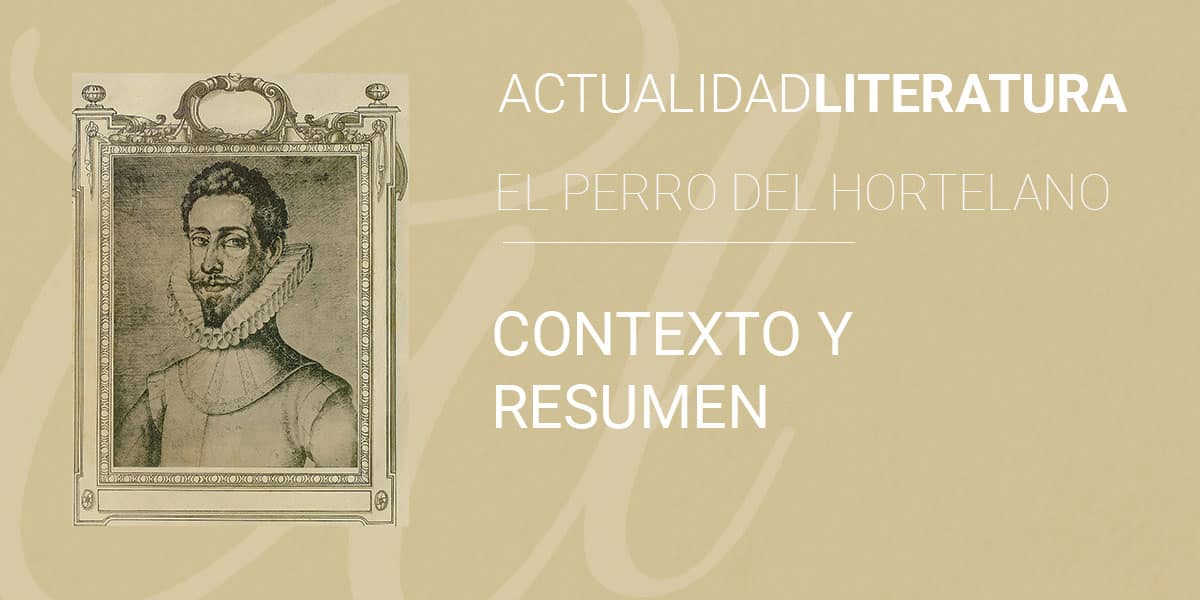
El Perro del Hortelano is a play written by the famous poet and playwright Lope de Vega. It is a 1618th century comedy, premiered in 1996. It has been adapted to the cinema, the medium through which it was made known by Pilar Miró, who adapted the work to film in XNUMX. The film was a great success and was starred by Emma Suárez, Ana Duato and Carmelo Gomez. This version was truly unique because the text was kept in verse.
In addition to being a creation of the famous Lope de Vega, El Perro del Hortelano It is recognized by the famous saying: "It's like the dog in the manger, who neither eats nor lets eat". The meaning of the saying is transferred to the entire work. If you do not know this work and want to know more, below you will find more information and a detailed summary.
Authorship and context
The play is inserted in the framework of the Spanish Golden Age, a time spanning the last third of the XNUMXth and XNUMXth centuries. The literary compositions of this time are considered the pinnacle of Spanish creation, as well as some of the most outstanding letters of literature from Latin America. In this context we find this comedy that, at the same time, belongs to what is popularly called «palatine comedy», a type of comedy, a subgenre that moves between humor and solemnity.
The author is also one of the greatest writers in Spanish literature, responsible for some of the best works in the Spanish language, Felix Lope de Vega y Carpio (1562-1635). He revolutionized the art of making comedies and he was a contemporary of Cervantes, who envied him for the tremendous success that Lope de Vega experienced in his professional career.
Therefore, El Perro del Hortelano was born at a time of cultural splendor, as well as economic and political, since Spain was in those times a world power. They were the golden years of an era that would end abruptly a few decades later.

The popular saying and argument of the work
Title El Perro del Hortelano honors the events of the play. Although a gardener is a horticulturist who is dedicated to growing fruit and vegetables in an orchard, his dog is his protector against vermin that may approach him. The striking thing is that a dog does not usually eat vegetables, he is a carnivore: he doesn't eat from the garden, but he doesn't let the other animals eat either. It is the same nonsense and absurdity in the behavior of the jealous protagonist, the Countess of Belflor who, since she cannot obtain the love of the man she loves, does not allow anyone else to woo him either.
The work and its message
The work could be read in a current way as if it were a soap opera. There are a series of comic events that make up the work, as well as a love story that seems to be a central part of it.However, it is not quite like that. There is a love element that is necessary due to the literature of that time, as it is a comedy and because the public also demanded it, had fun and could empathize with the characters. Although it is true, the work has a serious moralizing message, precisely because of the lack of morality of its protagonists.. The comedy, with an attractive plot, has a double objective: to entertain people (which generates success and raises money) and to show behavior that serves as a lesson.
The dog in the manger: summary
Preliminaries of the work
The action takes place in Naples when the region belonged to the Spanish Crown. Broadly speaking, it is a story made up of a love triangle full of doubts and hesitations., created by Countess Diana de Belflor, her secretary Teodoro and Marcela, lady of the Countess who is in relations with Teodoro. However, more characters become involved in the convoluted relationships.

love entanglements
Teodoro and Marcela have an affair. The two belong to the entourage of the Countess of Belflor who, when she finds out about the love affair between her secretary and his lady, begins to feel jealous and she thinks she loves Teodoro. Marcela confesses that she is with Teodoro, but they plan to get married, feeling her honor compromised, and then the duchess gives her approval.
However, the Countess has other plans. Write a love letter to Teodoro and he, who really only intends to find better fortune and move up the social ladder, he is confident that he may have a real chance to marry his mistress. So he leaves Marcela and she, hurt, seeks comfort in a servant named Fabio.
But Diana has a highly changeable character. He believes that his status is too high to be carried away by a passion and she looks for someone of her same position among her suitors, such as the Marquis Ricardo or Count Federico. Then Teodoro looks for Marcela, who leaves Fabio and forgives her secretary.
However, When the Countess of Belflor learns of the reconciliation of her lady and her secretary, she speaks directly to Theodore and confesses her feelings to him, agreeing that in this situation Marcela must marry her boyfriend Fabio. And then, although the Countess definitively rejects her suitors, Count Federico and the Marquis Ricardo, Teodoro lets her know that he does not want to remain in uncertainty any longer and returns to Marcela..
The Plan: Count Ludovico
The nobles, being rejected by the countess and after understanding that the reason for this is a commoner, order Teodoro to be killed. and the order is given to Tristán, Teodoro's loyal servant and friend. In her place, Tristan alerts her master and helps her pose as a noble, in order to get a position commensurate with Diana's in order to marry her.
Tristán goes to Count Ludovico because he lost his son (also called Teodoro) a long time ago. He introduces himself as the merchant who has bought it in distant lands, assuming that Teodoro is not a slave, but his lost son. And the nobleman accepts it delighted with the idea that he has finally recovered his offspring.
tangle resolution
Finally, everyone finds the story of Teodoro and his father Count Ludovico true. Although somewhat stupefied, Countess Belflor believes it possible to marry Teodoro as he really has noble blood. So that, Diana marries Teodoro, who manages to rise, as he wanted, in society, and Marcela, after all the mess, ends up marrying Fabio, the countess's servant.